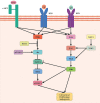Individualized Treatment Strategy for Cutaneous Melanoma: Where Are We Now and Where Are We Going?
- PMID: 34804979
- PMCID: PMC8599821
- DOI: 10.3389/fonc.2021.775100
Individualized Treatment Strategy for Cutaneous Melanoma: Where Are We Now and Where Are We Going?
Abstract
In the past several decades, innovative research in cancer biology and immunology has contributed to novel therapeutics, such as targeted therapy and immunotherapy, which have transformed the management of patients with melanoma. Despite the remarkable therapeutic outcomes of targeted treatments targeting MAPK signaling and immunotherapy that suppresses immune checkpoints, some individuals acquire therapeutic resistance and disease recurrence. This review summarizes the current understanding of melanoma genetic variations and discusses individualized melanoma therapy options, particularly for advanced or metastatic melanoma, as well as potential drug resistance mechanisms. A deeper understanding of individualized treatment will assist in improving clinical outcomes for patients with cutaneous melanoma.
Keywords: MAPK; immunotherapy; melanoma; resistance; targeted therapy.
Copyright © 2021 Zeng, Liu, Zhou and Zeng.
Conflict of interest statement
The authors declare that the research was conducted in the absence of any commercial or financial relationships that could be construed as a potential conflict of interest.
Figures



Similar articles
-
Future perspectives in melanoma research: meeting report from the "Melanoma Bridge": Napoli, December 3rd-6th 2014.J Transl Med. 2015 Nov 30;13:374. doi: 10.1186/s12967-015-0736-1. J Transl Med. 2015. PMID: 26619946 Free PMC article.
-
Current Melanoma Treatments: Where Do We Stand?Cancers (Basel). 2021 Jan 9;13(2):221. doi: 10.3390/cancers13020221. Cancers (Basel). 2021. PMID: 33435389 Free PMC article. Review.
-
Combining immunotherapy with oncogene-targeted therapy: a new road for melanoma treatment.Front Immunol. 2015 Feb 9;6:46. doi: 10.3389/fimmu.2015.00046. eCollection 2015. Front Immunol. 2015. PMID: 25709607 Free PMC article. Review.
-
New drug targets in metastatic melanoma.J Pathol. 2014 Jan;232(2):134-41. doi: 10.1002/path.4259. J Pathol. 2014. PMID: 24027077 Review.
-
New therapies in the treatment of melanoma.Expert Opin Investig Drugs. 2012 Nov;21(11):1643-59. doi: 10.1517/13543784.2012.713938. Epub 2012 Aug 9. Expert Opin Investig Drugs. 2012. PMID: 22876817 Free PMC article. Review.
Cited by
-
Managing Metastatic Melanoma in 2022: A Clinical Review.JCO Oncol Pract. 2022 May;18(5):335-351. doi: 10.1200/OP.21.00686. Epub 2022 Feb 8. JCO Oncol Pract. 2022. PMID: 35133862 Free PMC article. Review.
-
A novel prognostic model for cutaneous melanoma based on an immune-related gene signature and clinical variables.Sci Rep. 2022 Nov 27;12(1):20374. doi: 10.1038/s41598-022-23475-4. Sci Rep. 2022. PMID: 36437242 Free PMC article.
-
The Combined Metabolically Oriented Effect of Fucoidan from the Brown Alga Saccharina cichorioides and Its Carboxymethylated Derivative with 2-Deoxy-D-Glucose on Human Melanoma Cells.Int J Mol Sci. 2023 Jul 27;24(15):12050. doi: 10.3390/ijms241512050. Int J Mol Sci. 2023. PMID: 37569428 Free PMC article.
-
Combined Radiomodifying Effect of Fucoidan from the Brown Alga Saccharina cichorioides and Pacificusoside D from the Starfish Solaster pacificus in the Model of 3D Melanoma Cells.Biomolecules. 2023 Feb 23;13(3):419. doi: 10.3390/biom13030419. Biomolecules. 2023. PMID: 36979354 Free PMC article.
-
Quality of Life Predictors in Patients With Melanoma: A Machine Learning Approach.Front Oncol. 2022 Mar 25;12:843611. doi: 10.3389/fonc.2022.843611. eCollection 2022. Front Oncol. 2022. PMID: 35402230 Free PMC article.
References
Publication types
LinkOut - more resources
Full Text Sources
Miscellaneous

